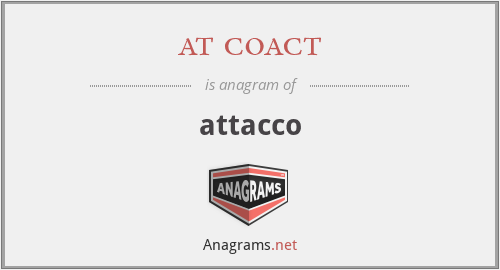What anagrams are available for attacco?
This page is about an anagram for the word at coact that can be used in word games, puzzles, trivia and other crossword based board games.
at coact
Translation
Find a translation for at coact in other languages:
Select another language:
- - Select -
- 简体中文 (Chinese - Simplified)
- 繁體中文 (Chinese - Traditional)
- Español (Spanish)
- Esperanto (Esperanto)
- 日本語 (Japanese)
- Português (Portuguese)
- Deutsch (German)
- العربية (Arabic)
- Français (French)
- Русский (Russian)
- ಕನ್ನಡ (Kannada)
- 한국어 (Korean)
- עברית (Hebrew)
- Gaeilge (Irish)
- Українська (Ukrainian)
- اردو (Urdu)
- Magyar (Hungarian)
- मानक हिन्दी (Hindi)
- Indonesia (Indonesian)
- Italiano (Italian)
- தமிழ் (Tamil)
- Türkçe (Turkish)
- తెలుగు (Telugu)
- ภาษาไทย (Thai)
- Tiếng Việt (Vietnamese)
- Čeština (Czech)
- Polski (Polish)
- Bahasa Indonesia (Indonesian)
- Românește (Romanian)
- Nederlands (Dutch)
- Ελληνικά (Greek)
- Latinum (Latin)
- Svenska (Swedish)
- Dansk (Danish)
- Suomi (Finnish)
- فارسی (Persian)
- ייִדיש (Yiddish)
- հայերեն (Armenian)
- Norsk (Norwegian)
- English (English)
Definition
What does attacco mean?
- Attacco
- Attacco, in music, indicates a short phrase, treated as a point of imitation; and employed, either as the subject of a fugue, as a subordinate element introduced for the purpose of increasing the interest of its development, as a leading feature in a motet, madrigal, full anthem, or other choral composition, or as a means of relieving the monotony of an otherwise too homogeneous part-song. The name comes from the Italian attaccare, "to unite" or "to bind together." Attacco (It.) (Lit., a binding together.) A 'point' of imitation—that is, any short passage or figure proposed for treatment by imitation. In fugues the attacco is often made from a fragment of the subject or of the andamento, but is sometimes quite independent. A striking instance of an attacco used as the subject of a fugue is J. S. Bach's The Well-Tempered Clavier, No. 27.When used merely as an accessory, it almost always represents a fragment of the true subject; as in this passage from "Ye House of Gilead," from Handel's Jephtha. In the madrigal and motet, a new attacco is usually introduced with each new paragraph of the verbal text; in the glee, properly so called, the part played by the attacco is less important; while in part-songs, its appearance as a prominent feature is still less frequent. It can, however, be found in John Wall Callcott's "Go, plaintive Breeze," in Felix Mendelssohn's four-part Lied Türkisches Schenkenlied: Setze mir nicht, du Grobian.
Embed
Citation
Use the citation below to add this anagram to your bibliography:
Style:MLAChicagoAPA
"at coact." Anagrams.net. STANDS4 LLC, 2024. Web. 18 May 2024. <https://www.anagrams.net/term/1230852>.



Discuss this attacco anagram with the community:
Report Comment
We're doing our best to make sure our content is useful, accurate and safe.
If by any chance you spot an inappropriate comment while navigating through our website please use this form to let us know, and we'll take care of it shortly.
Attachment
You need to be logged in to favorite.
Log In